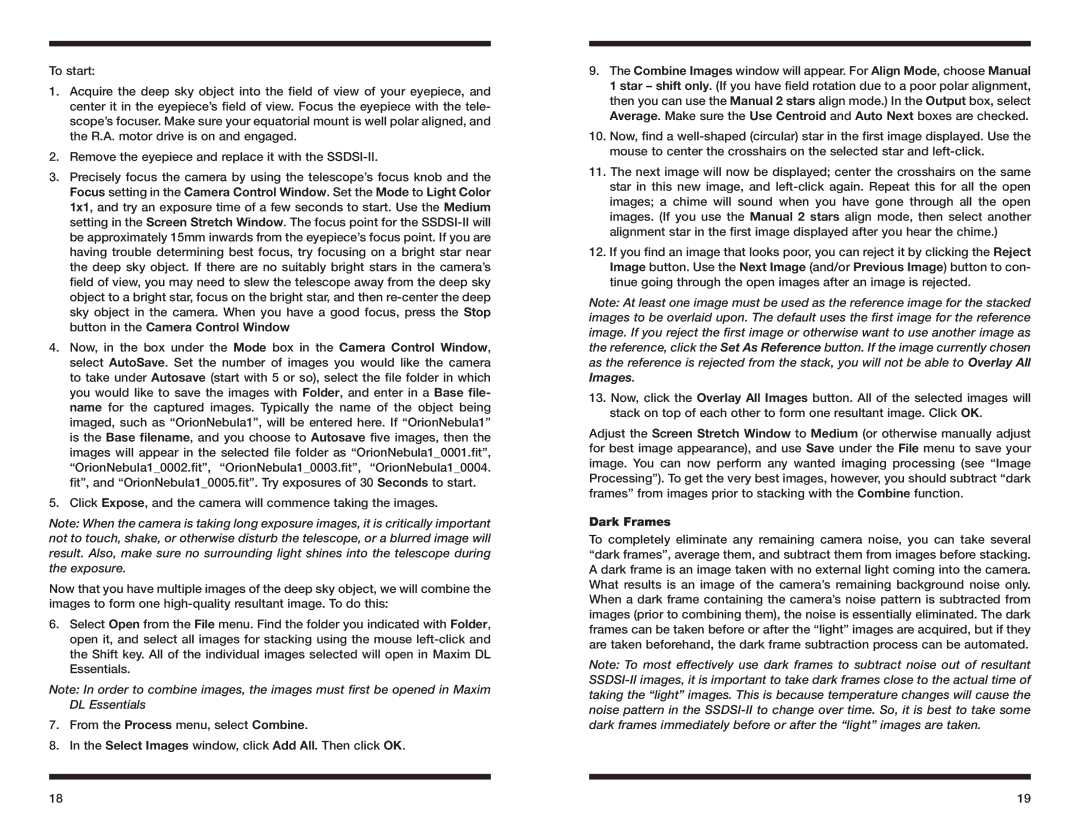
To start:
1.Acquire the deep sky object into the field of view of your eyepiece, and center it in the eyepiece’s field of view. Focus the eyepiece with the tele- scope’s focuser. Make sure your equatorial mount is well polar aligned, and the R.A. motor drive is on and engaged.
2.Remove the eyepiece and replace it with the
3.Precisely focus the camera by using the telescope’s focus knob and the Focus setting in the Camera Control Window. Set the Mode to Light Color 1x1, and try an exposure time of a few seconds to start. Use the Medium setting in the Screen Stretch Window. The focus point for the
4.Now, in the box under the Mode box in the Camera Control Window, select AutoSave. Set the number of images you would like the camera to take under Autosave (start with 5 or so), select the file folder in which you would like to save the images with Folder, and enter in a Base file- name for the captured images. Typically the name of the object being imaged, such as “OrionNebula1”, will be entered here. If “OrionNebula1” is the Base filename, and you choose to Autosave five images, then the images will appear in the selected file folder as “OrionNebula1_0001.fit”, “OrionNebula1_0002.fit”, “OrionNebula1_0003.fit”, “OrionNebula1_0004. fit”, and “OrionNebula1_0005.fit”. Try exposures of 30 Seconds to start.
5.Click Expose, and the camera will commence taking the images.
Note: When the camera is taking long exposure images, it is critically important not to touch, shake, or otherwise disturb the telescope, or a blurred image will result. Also, make sure no surrounding light shines into the telescope during the exposure.
Now that you have multiple images of the deep sky object, we will combine the images to form one
6.Select Open from the File menu. Find the folder you indicated with Folder, open it, and select all images for stacking using the mouse
Note: In order to combine images, the images must first be opened in Maxim DL Essentials
7.From the Process menu, select Combine.
8.In the Select Images window, click Add All. Then click OK.
9.The Combine Images window will appear. For Align Mode, choose Manual 1 star – shift only. (If you have field rotation due to a poor polar alignment, then you can use the Manual 2 stars align mode.) In the Output box, select Average. Make sure the Use Centroid and Auto Next boxes are checked.
10.Now, find a
11.The next image will now be displayed; center the crosshairs on the same star in this new image, and
12.If you find an image that looks poor, you can reject it by clicking the Reject Image button. Use the Next Image (and/or Previous Image) button to con- tinue going through the open images after an image is rejected.
Note: At least one image must be used as the reference image for the stacked images to be overlaid upon. The default uses the first image for the reference image. If you reject the first image or otherwise want to use another image as the reference, click the Set As Reference button. If the image currently chosen as the reference is rejected from the stack, you will not be able to Overlay All Images.
13.Now, click the Overlay All Images button. All of the selected images will stack on top of each other to form one resultant image. Click OK.
Adjust the Screen Stretch Window to Medium (or otherwise manually adjust for best image appearance), and use Save under the File menu to save your image. You can now perform any wanted imaging processing (see “Image Processing”). To get the very best images, however, you should subtract “dark frames” from images prior to stacking with the Combine function.
Dark Frames
To completely eliminate any remaining camera noise, you can take several “dark frames”, average them, and subtract them from images before stacking. A dark frame is an image taken with no external light coming into the camera. What results is an image of the camera’s remaining background noise only. When a dark frame containing the camera’s noise pattern is subtracted from images (prior to combining them), the noise is essentially eliminated. The dark frames can be taken before or after the “light” images are acquired, but if they are taken beforehand, the dark frame subtraction process can be automated.
Note: To most effectively use dark frames to subtract noise out of resultant
18 | 19 |
